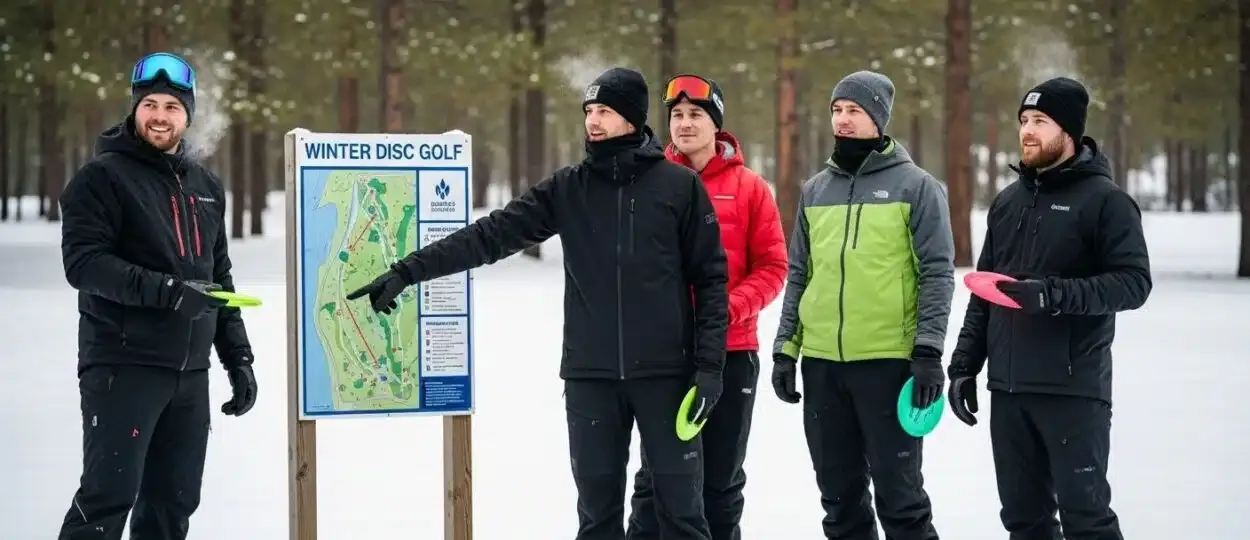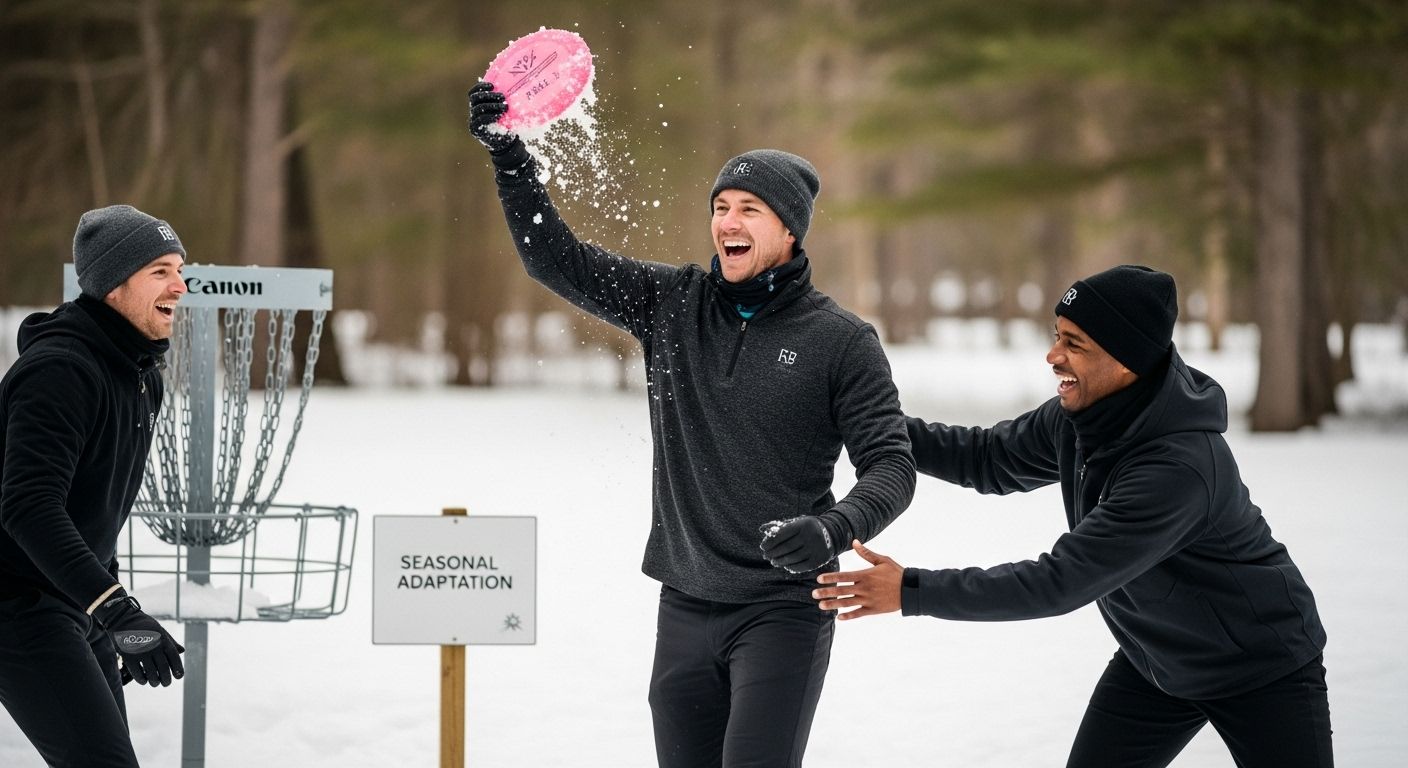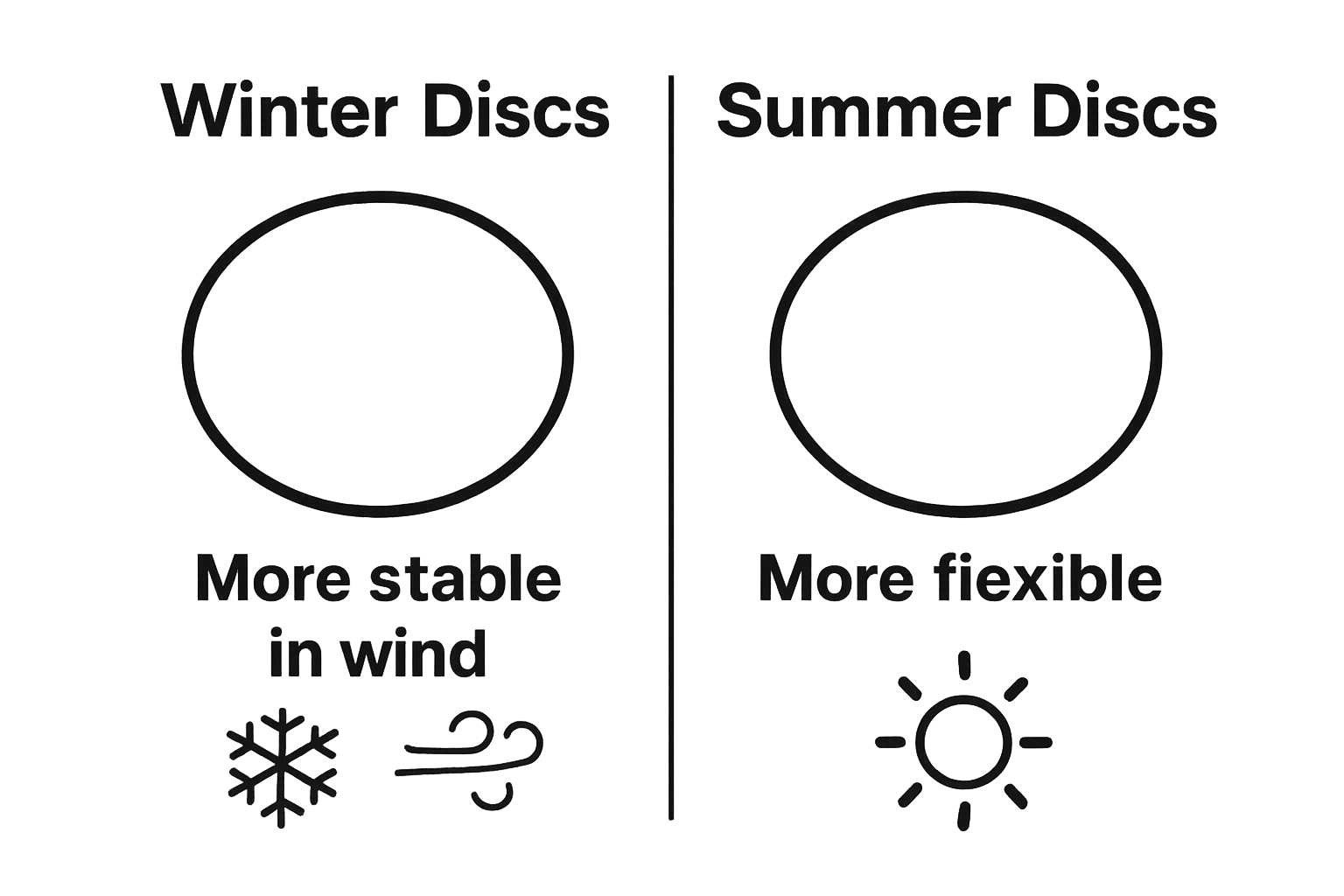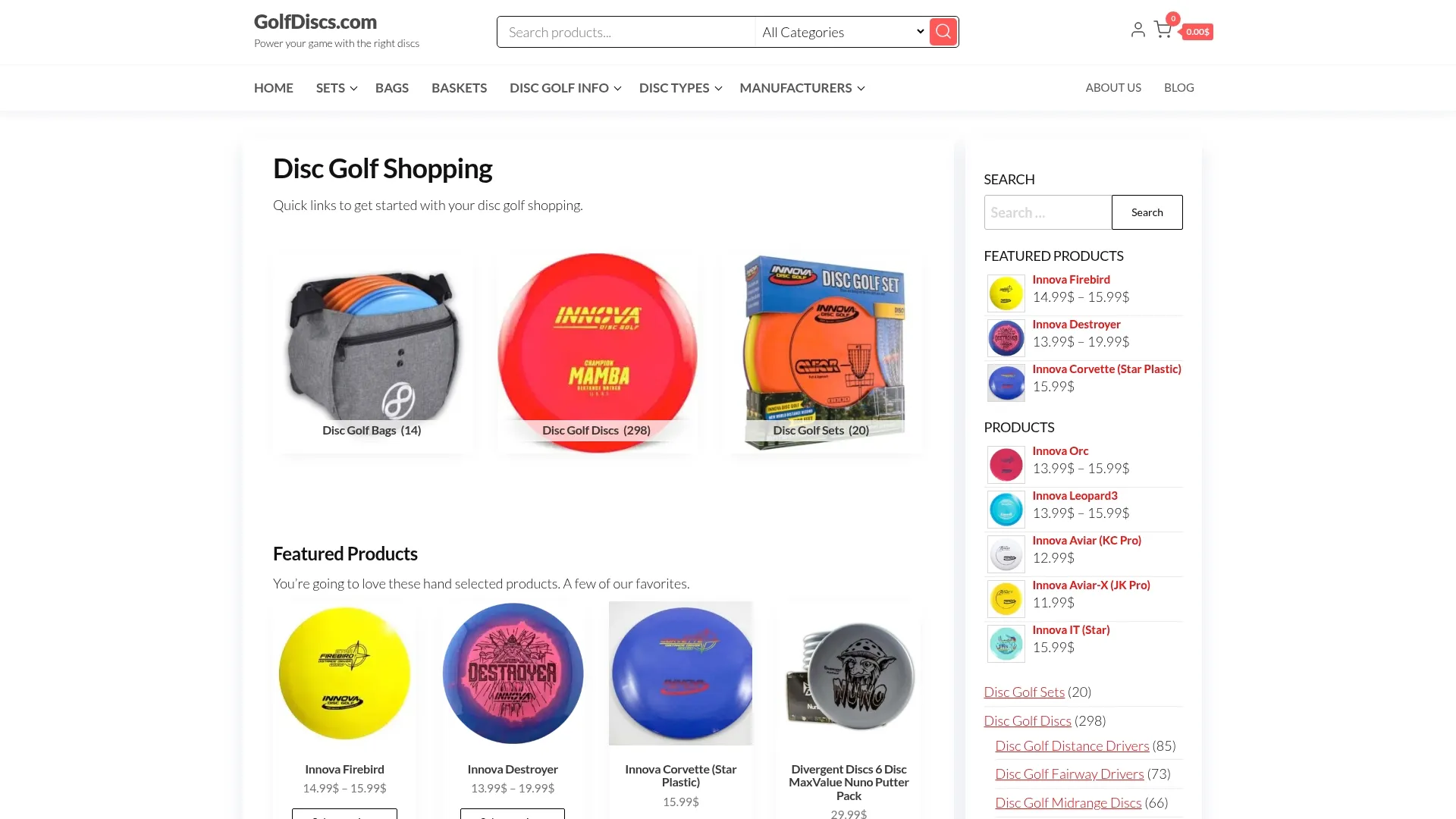
Understanding Disc Golf in Winter: Thriving in Cold Weather
Disc golf does not go into hibernation when winter hits. In fact, courses in places like Michigan see a surge in players using snowshoes and bright discs to tackle icy fairways. Most people expect these cold months to freeze the fun right out of the game. Instead, winter brings a whole new set of challenges and surprises that actually make disc golf even more thrilling and unpredictable.
Table of Contents
- What Is Disc Golf In Winter And How Does It Differ From Other Seasons?
- The Importance Of Seasonal Adaptation In Disc Golf
- Understanding The Impact Of Weather Conditions On Gameplay
- Key Equipment Considerations For Winter Disc Golf
- Engaging With The Disc Golf Community During Cold Months
Quick Summary
| Takeaway | Explanation |
|---|---|
| Adapt gameplay for winter conditions. | Snow and cold alter disc flight and player strategies, requiring adaptation in approach and techniques. |
| Select specialized winter discs. | Use overstable discs for better handling of wind and snow, improving performance in harsh conditions. |
| Layer clothing for warmth and mobility. | Waterproof and thermal layers keep players warm while allowing full range of movement during play. |
| Engage with the disc golf community. | Participate in winter activities and events to stay motivated and connected with fellow players during the off-season. |
| Prepare for variable weather effects. | Understand how wind and temperature influence gameplay to enhance performance and resilience on the course. |
What is Disc Golf in Winter and How Does It Differ from Other Seasons?
Disc golf transforms into a unique sporting experience during winter, presenting players with challenging and exhilarating opportunities that distinguish it from warmer season play. Unlike traditional golf, disc golf adapts remarkably well to cold weather conditions, offering enthusiasts a chance to continue their passion throughout the year. Learn more about disc golf fundamentals to understand how the sport remains engaging across different environmental conditions.
Unique Winter Course Dynamics
Winter disc golf introduces players to a dramatically altered landscape where standard gameplay strategies require significant modification. Snow-covered terrain changes disc trajectory, creating unexpected bounces and sliding patterns that test a player’s adaptability. According to the Michigan Department of Natural Resources, winter disc golf can involve hiking or snowshoeing across courses, transforming the activity into a more comprehensive outdoor experience.
Equipment and Performance Considerations
Players must adjust their approach and equipment for winter disc golf. Cold temperatures significantly impact disc performance, causing plastic to become more rigid and less flexible. Specialized winter discs become crucial, with players often selecting more overstable discs that can better handle wind and resist unpredictable snow-influenced flight paths. Key winter disc golf adaptations include:
- Using brighter colored discs for enhanced visibility against snow
- Wearing layered, waterproof clothing for temperature management
- Selecting discs with more stable flight characteristics
The winter season challenges disc golfers to develop enhanced skills, transforming the sport from a fair-weather activity into a year-round pursuit that rewards technical proficiency and mental resilience.
The following table summarizes the most important differences between playing disc golf in winter versus other seasons to help players quickly understand how their approach should change.
| Aspect | Winter Disc Golf | Other Seasons (Spring/Summer/Fall) |
|---|---|---|
| Terrain | Snow and ice; may require snowshoes, slick | Grass and dirt; generally solid footing |
| Disc Performance | Plastic more rigid, overstable discs utilized | Normal flexibility and disc selection |
| Visibility | Bright discs often used for snow contrast | Standard disc colors usually suffice |
| Clothing Requirements | Layered, thermal, waterproof | Lightweight, breathable, weather-optional |
| Mobility | May be hindered by bulkier clothing | Full mobility with less restrictive gear |
| Course Activity | Lower number of events, community adaptation | More tournaments and social play |
| Strategy | Adapted for wind, uneven footing, cold hands | Standard strategies for traction, mobility |
The Importance of Seasonal Adaptation in Disc Golf
Seasonal adaptation represents a critical skill for disc golf enthusiasts, transforming the sport from a fair-weather activity into a year-round passion. Understanding how environmental changes impact gameplay allows players to maintain performance and enjoyment across varying conditions. Explore advanced disc golf techniques to enhance your ability to adapt to different seasonal challenges.
Physical and Mental Resilience
Adapting to seasonal variations demands more than technical skills it requires comprehensive physical and mental preparation. Cold weather introduces unique challenges that test a player’s resilience and technical proficiency. According to research from the journal Sports, athletes who successfully adapt to environmental changes demonstrate superior performance and reduced risk of injury.
Strategic Equipment and Technique Modifications
Successful seasonal adaptation in disc golf involves strategic modifications to both equipment and playing techniques. Winter performance requires players to reimagine their approach, considering factors like disc selection, clothing layers, and course navigation. Key adaptation strategies include:
- Selecting discs with more stable flight characteristics
- Investing in moisture-wicking and insulating clothing
- Developing throwing techniques that account for wind and terrain variations
- Practicing balance and stability in challenging surface conditions
By embracing seasonal changes, disc golfers transform potential limitations into opportunities for skill development and personal growth, ensuring the sport remains engaging and challenging throughout the year.

Understanding the Impact of Weather Conditions on Gameplay
Weather conditions play a pivotal role in disc golf performance, dramatically influencing disc flight, player strategy, and overall gameplay experience. Environmental factors transform the disc golf landscape, requiring players to develop sophisticated adaptability skills. Discover advanced disc golf stability techniques to better comprehend how external conditions impact disc behavior.
Wind and Temperature Dynamics
Wind represents the most significant environmental challenge in disc golf, fundamentally altering disc trajectory and flight characteristics. According to research analyzing sports performance, increased wind speeds can substantially modify player outcomes by creating unpredictable disc movements. Temperature further complicates gameplay, causing disc plastics to become more rigid in cold conditions and potentially reducing throwing distance and accuracy.
Physical Performance and Environmental Adaptation
Cold weather significantly impacts athletic performance, challenging disc golfers to modify their physical approach. Physiological responses to low temperatures can include reduced muscle flexibility, decreased cardiovascular efficiency, and increased energy expenditure. Key considerations for maintaining performance include:
- Implementing dynamic warm-up routines to counteract muscle stiffness
- Wearing layered, moisture-wicking clothing for temperature regulation
- Adjusting throwing techniques to compensate for reduced muscle elasticity
- Maintaining proper hydration despite reduced thirst perception in cold environments
By understanding and anticipating these weather-related challenges, disc golfers can transform environmental obstacles into opportunities for skill refinement and strategic gameplay.
Key Equipment Considerations for Winter Disc Golf
Winter disc golf demands specialized equipment that enables players to navigate challenging environmental conditions while maintaining performance and enjoyment. Strategic gear selection becomes crucial in transforming potential obstacles into opportunities for dynamic gameplay. Explore winter disc golf preparation tips to understand how proper equipment can enhance your cold-weather experience.
Disc Selection and Performance
Disc performance dramatically changes in cold temperatures, requiring players to thoughtfully choose equipment that can withstand harsh conditions.

Plastic composition becomes more rigid, affecting flight characteristics and throwing dynamics. According to the Professional Disc Golf Association, selecting the right discs can significantly mitigate environmental challenges.
Protective Gear and Clothing Strategy
Successful winter disc golf hinges on comprehensive protective gear that balances warmth, mobility, and performance. Essential winter disc golf equipment encompasses more than just discs and involves strategic clothing layers designed to maintain body temperature and facilitate unrestricted movement. Key equipment considerations include:
- Waterproof, breathable outer layers to prevent moisture retention
- Thermal base layers that provide insulation without restricting arm movement
- Specialized gloves that maintain grip and hand warmth
- Traction-enhanced footwear for stability on slippery surfaces
- Bright-colored discs and accessories to improve visibility in snow
By carefully selecting and integrating specialized equipment, disc golfers can transform winter conditions from potential deterrents into exciting opportunities for skill development and unique playing experiences.
This table outlines essential winter equipment considerations for disc golfers, comparing the primary function of each item and providing an example of its adaptation for cold-weather play.
| Equipment Type | Winter Function | Cold-Weather Adaptation Example |
|---|---|---|
| Discs | Retain predictable flight in cold/wind | Overstable, brightly-colored discs |
| Outerwear | Keeps player dry and warm | Waterproof, breathable jackets |
| Base Layer | Provides insulation and wicks moisture | Thermal shirts, moisture-wicking materials |
| Gloves | Enhance grip/warmth without impairing throwing | Specialized throwing gloves |
| Footwear | Maintains traction and stability | Shoes/boots with enhanced treads or spikes |
| Accessories | Improve play and visibility | Towels, hand warmers, bright disc markers |
Engaging with the Disc Golf Community During Cold Months
The disc golf community demonstrates remarkable resilience during winter, transforming potential seasonal limitations into opportunities for connection, skill development, and shared experiences. Community engagement becomes a critical strategy for maintaining motivation and enthusiasm when outdoor conditions pose challenges. Discover winter playing techniques to understand how players stay connected and active during colder periods.
Virtual and Local Community Connections
Digital platforms and local disc golf organizations play a pivotal role in sustaining community interaction during winter months. According to community engagement research, local disc golf associations frequently organize events that maintain player connections and interest. Online forums, social media groups, and regional tournaments provide alternative spaces for interaction when traditional outdoor play becomes limited.
Structured Winter Community Activities
Successful winter disc golf communities develop innovative approaches to maintain player engagement and skill development. Structured winter activities help players stay connected, motivated, and prepared for the upcoming playing season. Key community engagement strategies include:
- Organizing indoor putting clinics and technique workshops
- Hosting virtual disc golf tournaments and skills challenges
- Creating online training and instructional video series
- Maintaining active social media groups for local disc golf enthusiasts
- Planning regular indoor meetups for equipment discussions and strategy sessions
By embracing creative community approaches, disc golf players transform winter from a potential interruption into an opportunity for growth, learning, and meaningful social connections.
Ready to Master Winter Disc Golf? Your Best Game Starts Here
Staying competitive in cold weather disc golf is no small feat. The challenges are real. From rigid discs to slippery fairways to the need for specialized gear and adaptation, winter can put both your passion and technique to the test. The article highlighted how crucial the right equipment and preparation are for thriving in these demanding conditions. If you are feeling frustrated by lost discs in the snow, struggling for grip, or finding your throws impacted by stiff plastic, you are not alone.

Now is the perfect moment to upgrade your winter disc golf experience. GolfDiscs.com offers hand-picked discs suited for cold weather, bright colorways for easy spotting, and essential apparel designed to keep you comfortable on the course. Explore our expert tips for playing frisbee golf in winter and discover essential disc golf basics to improve your play year-round. Beat the cold, conquer any course, and step up your game. Visit GolfDiscs.com and get ready for your best winter rounds ever.
Frequently Asked Questions
What are the key differences in disc performance during winter?
Cold temperatures can make disc plastics more rigid, affecting their flight characteristics. Players often need to select more overstable discs that can handle wind and unpredictable snow conditions.
How should I dress for disc golf in winter conditions?
Wearing layered, waterproof clothing is essential for managing temperature and mobility. Key items include thermal base layers, breathable outer layers, and specialized gloves for grip and warmth.
What techniques should I modify for winter disc golf?
Adapting throwing techniques to compensate for reduced muscle elasticity in the cold is crucial. Additionally, practicing balance and stability on slippery surfaces will enhance performance during winter play.
How can I stay engaged with the disc golf community during winter?
Players can maintain engagement by participating in online forums, joining local clubs, and attending winter workshops or indoor clinics. Virtual tournaments and social media groups also provide excellent platforms for connection and skill development.
